For years, business intelligence has been about what you could see — static dashboards, historical trends, and curated reports. But as enterprise data volumes grow and decision cycles shrink, that model is reaching its limits. Visibility alone isn’t enough.
Today’s business landscape demands tools that don’t just present insight but generate it, on demand, in context, and in plain language. Generative BI changes how enterprise teams access and act on intelligence. It brings together large language models, natural language querying, and AI agents to make data analytics more intuitive, more interactive, and more aligned with the pace of business.
And this is more than a simple technical upgrade. Instead, it’s a structural reset that changes everything about how intelligence flows through the organisation. Businesses don't have to rely on analysts to build reports or interpret trends for them. With generative BI, they're able to ask direct questions and get immediate AI-driven responses.
This could be things like a dynamic chart, a scenario model, or root-cause analysis and recommendations to address any issues. Decisions are no longer downstream from insight. They happen in the same moment, with the same tool. That shift is already underway — and it’s accelerating. Gartner projects that by 2026, more than 80 % of enterprises will have used generative AI APIs or deployed GenAI-enabled applications, rising from less than 5 % in 2023.
As enterprise technology leaders look to modernise their data ecosystems, generative business intelligence is emerging as a capability that drives faster alignment, clearer decisions, and measurable performance. But the value isn’t in the feature set.
It’s in how organisations design, govern, and deploy these tools to support real data driven decisions across the business.
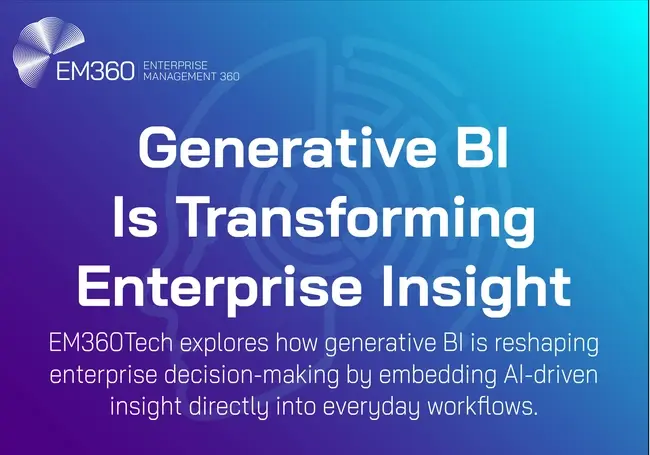
What Is Generative BI — And Why Now?
Generative BI is what happens when business intelligence meets generative AI. It’s not a new category of tools. It’s the evolution of what BI is expected to do — moving beyond dashboards and reports into systems that can interpret plain language, generate new outputs, and deliver insight directly into decision points.
That evolution builds on the progress enterprises have already made. From traditional BI to embedded analytics and self-service platforms, the goal has always been the same: get insight closer to the business user.
But where self-service BI still relies on predefined metrics and manual queries, generative BI introduces large language models (LLMs), semantic context, and AI agents that change the interaction entirely. Instead of selecting from existing options, users can describe what they want in their own terms — and get answers built for the moment.
The shift is timely. With AI in business intelligence becoming a core differentiator, enterprise teams are under pressure to reduce latency between data, insight, and action. And with business users demanding faster access to context-rich insight, GenBI is emerging not as an upgrade but as a new baseline.
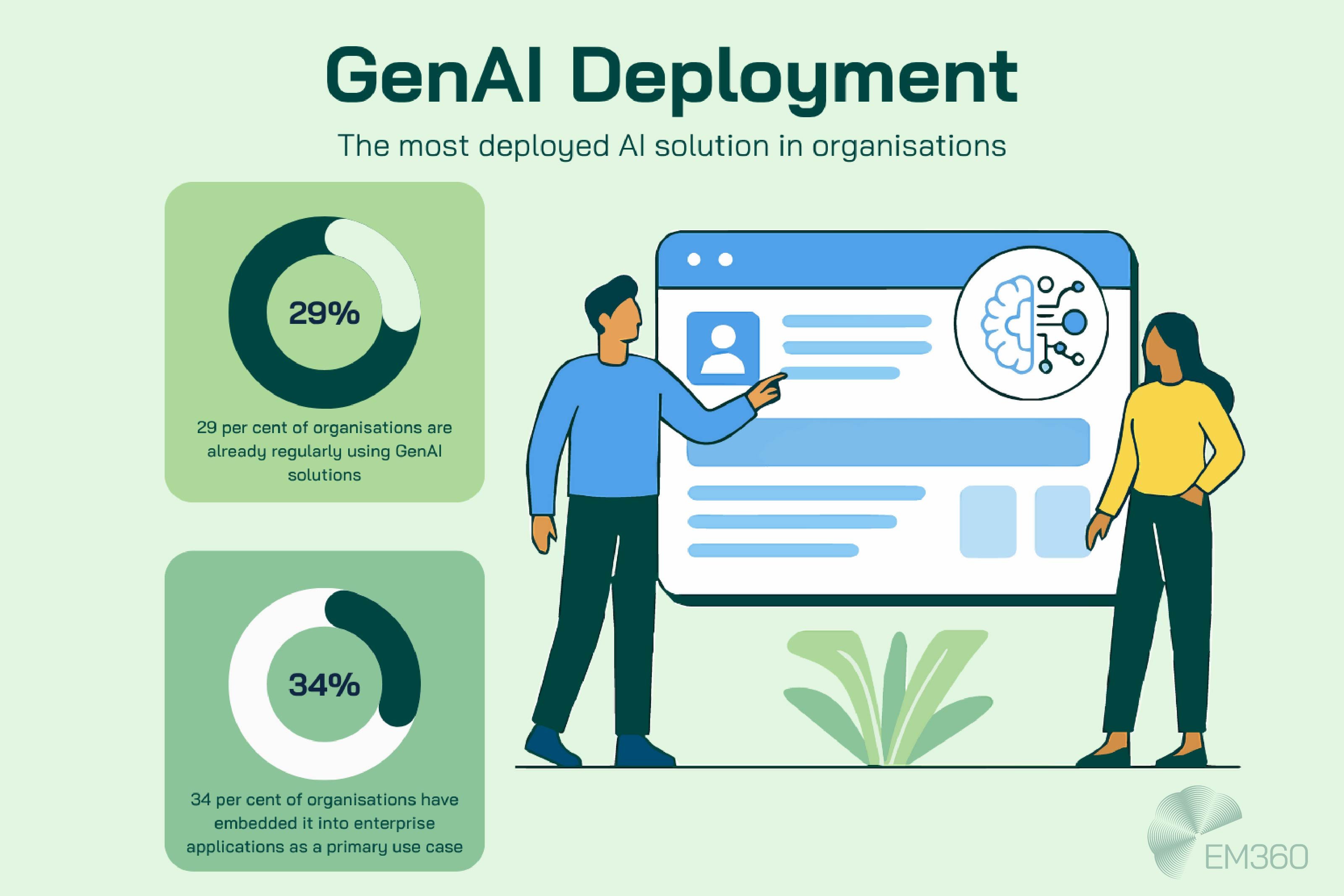
According to Gartner, generative AI is now the most frequently deployed AI solution in organisations — with 29 % already using it and another 34 % embedding it into enterprise applications as a primary use case. One where speed, relevance, and usability are non-negotiable.
Generative BI vs traditional BI tools
What makes generative BI different isn’t just the interface — it’s the operating model. The focus of traditional BI tools is retrieving and displaying data. GenBI, on the other hand, is focused on actively generating insights based on natural language input, historical context, and embedded models.
That means business users don’t need to know what chart to build or which filters to apply. They can simply ask. Natural language querying (NLQ) replaces dropdowns and dashboards with direct requests: “Show me our top-performing regions by margin, excluding promotional discounts.”
The system doesn’t just fetch the data. It applies logic, surfaces trends, and visualises the answer — all without manual input from an analyst. This doesn't mean you just get faster answers than you could before. It's actually a whole different relationship between teams and their data.
Forrester reports that AI-based functionality now powers around 80 % of a typical enterprise BI platform — from NLQ and natural language generation (NLG) to semantic enrichment, anomaly detection, and beyond.
Users are able to ask questions in plain language and get actionable insights, which means BI is suddenly less about access and more about acceleration.
What’s powering the shift to GenBI?
Several technologies are converging to make generative BI possible. At the centre are large language models (LLMs) — trained on billions of data points, capable of understanding enterprise queries in all their messy, human nuance.
These models are being embedded into BI platforms alongside semantic layers that translate user questions into structured, governed data logic.
This semantic layer is essential to the whole process in fact. With it, there are shared definitions and agreed metrics that help the system know exactly what someone means when they ask for information about ‘customer churn’.
This governance layer is what makes it safe to scale GenBI within your organisation. And what makes sure the outputs are consistent across teams, and can also be trusted. Platforms like Pyramid Analytics and Google Looker are already integrating these capabilities into their enterprise stacks.
AI agents can now monitor data flows, flag anomalies, and even initiate proactive insights based on evolving conditions.
Gartner predicts that by 2027, more than 50 % of generative AI models used by enterprises will be industry or function-specific — a sharp rise from just 1 % in 2023. And by 2028, one-third of generative AI interactions will invoke agentic workflows, enabling autonomous action as part of everyday enterprise operations.
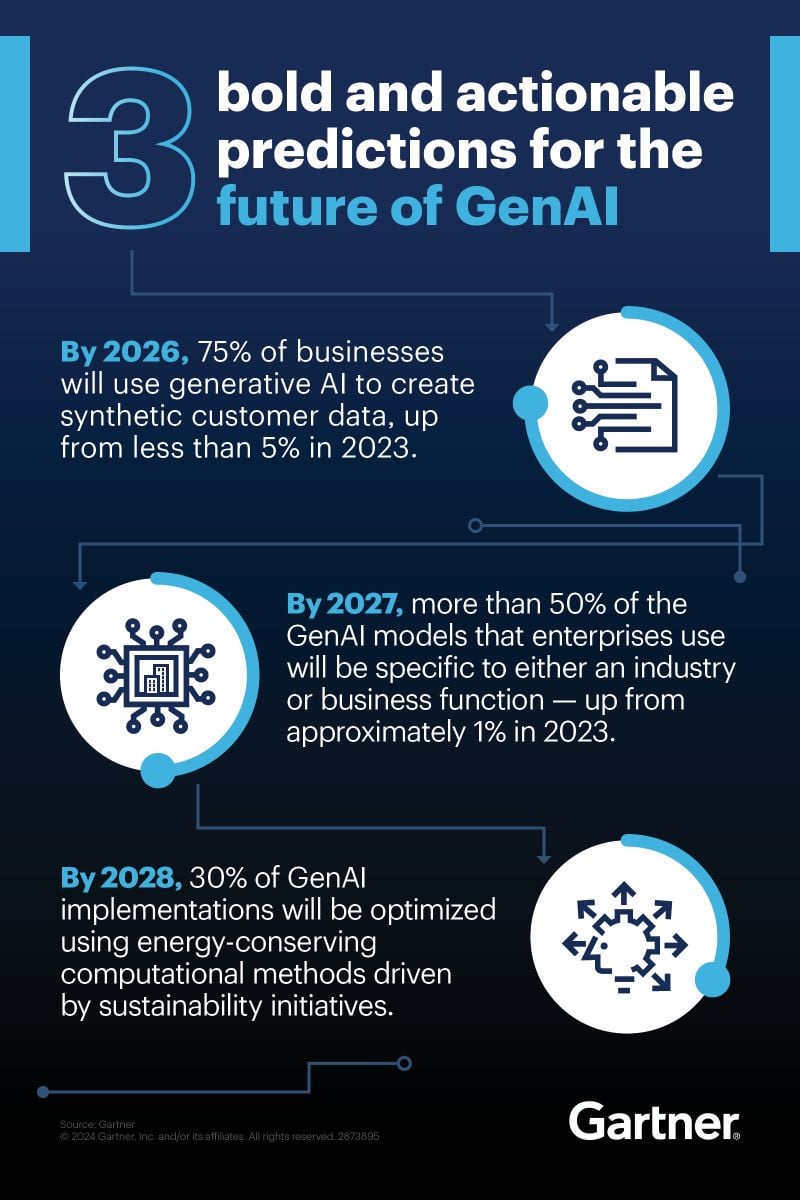
And because this is layered on top of cloud-native data platforms, it scales with the business — not around it.
Generative BI in Action — How It Changes the Enterprise Data Experience
Generative BI isn’t just about changing how people query data. Instead it’s about changing how they experience it. GenBI gets rid of the technical barriers between question and answer. The insights it provides are more relevant and more immediate, which means they’re more useful in the moment.
The result is a more intuitive, responsive layer of intelligence that lets business users engage with data on their own terms — and act with confidence. This shift is being felt across every function.
Not because of what GenBI adds, but because of what it removes: bottlenecks, translation layers, and time spent navigating dashboards instead of making decisions.
From questions to answers — natural language querying at scale
The most immediate change users notice is how they interact with data. Instead of opening a dashboard or navigating filters, they just ask. Natural language queries let business users describe what they want in their own words — and receive structured, visualised answers in return.
That removes a huge amount of friction. A finance manager doesn’t need to understand the data model to explore revenue by segment. A marketer doesn’t need to know which table holds customer churn metrics. They just ask. And the system returns a clean visual, a clear summary, or even a follow-up question to help refine the insight.
This kind of interaction doesn’t just reduce dependency on data teams. It brings insight into more conversations, more meetings, and more everyday decisions — without slowing anyone down.
From insights to impact — agentic BI and autonomous analytics
Generative BI isn’t limited to user prompts either. Add AI agents into the mix, and now the insights you're getting are proactive. Before anyone even thinks to look for them, these agents are monitoring data flows, flagging anomalies, and identifying trends.
That means performance drops, behavioural shifts, or forecast variances are flagged automatically. Teams get alerts about the things that matter — not just when they remember to check, and not just for what they haven't turned off. And with the right setup, those alerts can include things like summaries of root-cause analysis, recommended actions, or simulations of what might happen next.
This is where BI starts to feel less like a reporting layer and more like an operational partner. A system that doesn’t just tell you what’s happening, but helps decide what to do about it.
From static to semantic — why the semantic layer matters
Underneath every generative BI experience is a foundation of shared meaning. That’s what the semantic layer provides. It connects the language people use to the data the system understands — translating everyday questions into governed, reliable queries.
Without that layer, plain language becomes a problem. “Customer churn” might mean different things to different teams. “Profitability” might be calculated in five different ways. When those differences go unchecked, insight becomes inconsistent. And decisions made on inconsistent data don’t hold up.

The semantic layer solves this by acting as a living business glossary. It defines key terms, aligns metrics, and ensures every answer comes from a source that’s trusted across teams. That’s what makes informed decisions possible — not just fast ones.
Where Generative BI Is Delivering Value Today
The clearest indicator that generative BI is ready for the enterprise isn’t in the roadmap — it’s in the results. Across planning, operations, and executive communication, GenBI is changing how decisions get made. Not by replacing analysts or dashboards, but by putting intelligence where it's needed, when it matters, and in a form that anyone can use.
Gartner forecasts that by 2027, AI agents will augment or automate 50 % of business decisions — up from virtually none in 2024. That trajectory underscores the shift already underway, where insight and action are no longer separate functions but part of the same process.
For enterprise technology leaders, the question has shifted from can we do this to how fast can we scale it.
Strategic planning and scenario simulation
One of the most immediate use cases for generative BI is helping executives model uncertainty. With access to governed data and contextual insight, teams can simulate scenarios on the fly. No need to wait for a data team to build models or run custom queries. GenBI lets decision-makers ask plain-language questions and get dynamic outputs in return.
What happens if revenue drops 10 per cent next quarter? What if inventory spikes or churn increases by five per cent? The system can show the impact, highlight the variables, and even suggest where intervention matters most.
These aren’t forecasts for future reporting. They’re interactive tools for strategy — built to help leaders course-correct in the moment, not after the fact.
Operational optimisation through real-time signals
On the operational side, generative BI is becoming the connective tissue between live data and frontline action. Sales teams can track pipeline shifts in real time. Marketing can spot campaign fatigue before performance drops. Support leads can identify rising ticket types or handle-time anomalies as they happen.
That responsiveness doesn’t come from dashboards. It comes from real time insights surfaced by agents, alerts, and auto-generated diagnostics that point directly to the issue.
And because the system can connect multiple data points — from CRM to ERP to behavioural analytics — it doesn’t just tell teams what changed. It helps them understand why, and what to do next.
Executive-ready narratives — data storytelling powered by AI
Generative BI also plays a growing role in how insight gets communicated. Leaders don’t just need the data. They need the story — the context, the relevance, the clarity. And they need it without spinning up a new report every week.
With generative storytelling features, BI systems can turn raw insight into polished summaries. A single request can generate a written update, a visual briefing, or even a slide-ready explanation of what's changed and why it matters.

This isn’t just a formatting trick. It’s about alignment. When every team sees the same AI-driven narrative — tailored to their role, updated in real time, and framed in business language — decisions move faster. Conversations stay focused. And BI becomes more than a source of truth. It becomes a source of clarity.
Common Barriers to GenBI Maturity — And How To Overcome Them
Generative BI promises a more intuitive, more intelligent layer of enterprise decision support. But delivering on that promise takes more than the right tools. It requires alignment between architecture, governance, and adoption — all working together to support meaningful, trusted insight.
When those elements fall out of sync, GenBI doesn’t fail quietly. It fails visibly. Inconsistent outputs. Missed signals. Distrust in results. These aren’t technical glitches. They’re maturity gaps. And for enterprise leaders, addressing them early is the difference between pilot fatigue and full-scale value.
Fragmented architecture and lack of semantic consistency
One of the fastest ways to undermine GenBI is with inconsistent architecture. When the data foundation is fragmented — with disconnected systems, duplicated metrics, or partial access controls — large language models cannot generate consistent results.
Even worse, without a semantic layer, the system doesn't know what the user actually means. “Monthly revenue” might include discounts in one dataset and exclude them in another. “Customer churn” could be based on tenure, contract status, or inactivity, depending on the source.
This leads to hallucinations, contradictions, or misleading outputs — not because the model is broken, but because the context isn’t clear.
The solution isn’t more modelling. It’s semantic consistency. That means aligning definitions, standardising business logic, and embedding those guardrails into every layer of the GenBI experience.
Low AI readiness and cross-functional misalignment
Another barrier is organisational. Many enterprises treat GenBI as an IT-led initiative, with ownership sitting inside data teams or innovation units. But the real users are business teams — and without the right enablement, they’re left out of the loop.
That creates a gap. AI agents get deployed, but no one knows how to interact with them. Insights get generated, but no one trusts or understands them. Models get built, but no one aligns on the purpose.
Gartner warns that more than 40 % of agentic AI projects will be abandoned by the end of 2027 — not because the tech fails, but because of unclear business value, rising operational costs, and vendor “agent washing.”
To close that gap, GenBI must be positioned as a shared capability. That means creating space for co-design, joint training, and business-led feedback. Adoption doesn’t come from more features. It comes from trusted insights that reflect how people actually work.
Governance gaps and explainability blind spots
Generative BI cannot scale without trust. And trust cannot exist without visibility. If no one knows how an answer was generated — or what data was used to produce it — confidence erodes quickly.
According to Euromonitor, only around 40 % of consumers currently trust generative AI, highlighting ongoing concerns about accuracy, transparency, and reliability. These concerns are magnified in an enterprise context, where decisions must be justified, traceable, and secure.
This is especially critical in regulated industries, where every recommendation, trend, or decision point must be traceable. Without clear data governance and auditability, GenBI becomes a liability, not a strength.
The good news is that governance doesn’t have to slow innovation. When built into the design from the start, explainability becomes part of the experience. Users can see the source, understand the model’s logic, and verify the output. That transparency doesn’t just reduce risk. It increases adoption.
For any enterprise serious about digital transformation, explainability isn’t optional. It’s foundational.
What Leaders Should Prioritise for Successful GenBI Adoption
Generative BI doesn’t succeed because of what it can do. It succeeds because of how well it fits into the way the organisation thinks, acts, and decides. That’s why the real work of GenBI maturity isn’t technical. It’s architectural, cultural, and operational.
For leaders shaping enterprise AI strategies, these are the priorities that make GenBI more than a proof of concept.
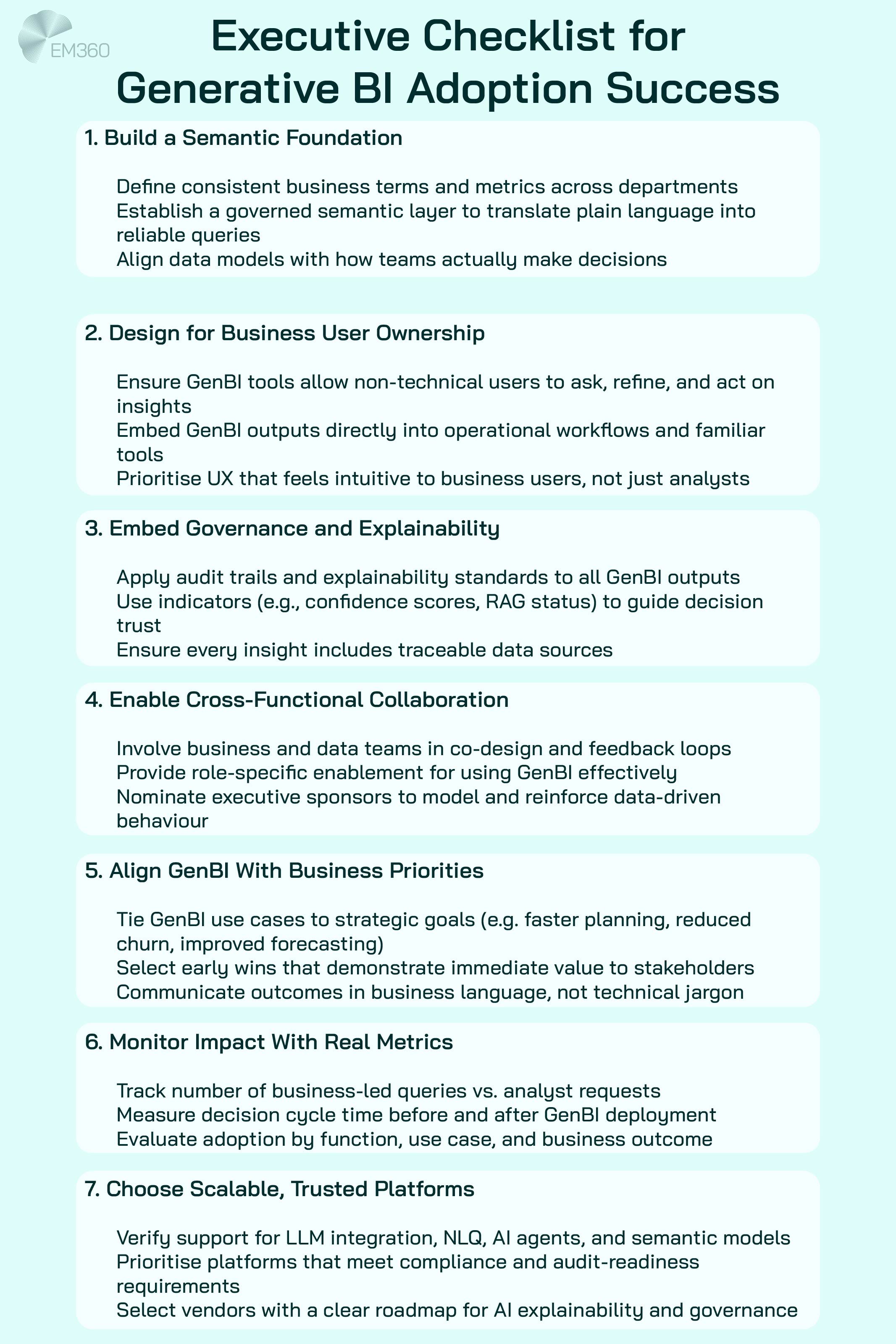
Build a semantic foundation first
Before deploying generative features, teams need shared meaning. That starts with definitions, data models, and business glossaries that reflect how the organisation actually works. If “retention,” “conversion,” or “profit” mean different things to different teams, plain language queries won’t help. They’ll confuse.
By investing early in semantic alignment, organisations can ensure that generative tools produce consistent, governed outputs. This isn’t back-end housekeeping. It’s what makes natural language usable across departments, and what keeps insight credible under pressure.
Establish guardrails for trust, transparency, and compliance
AI-generated insights need to be explainable by design. That means audit trails, explainability standards, and built-in indicators of data quality and model confidence. Whether it’s a written rationale, a confidence score, or a RAG status, users need to see how an output was created and why it can be trusted.
This is especially important for regulated sectors and board-level decisions. The more visible the logic, the more likely users are to rely on it.
Without guardrails, even the best AI-driven features fall short. With them, GenBI becomes a source of both speed and assurance.
Design for business ownership, not just data access
The goal of GenBI isn’t just to deliver answers. It’s to make insight usable by the people who need it most — without dependency on technical teams.
That means designing for interaction, not just output. Interfaces that let business users ask questions, refine results, and follow up on context. Features that provide actionable insights, not just raw information. Workflows that embed insight directly into the tools people already use.
Ownership happens when users see the value and feel confident using it. GenBI should lower the barrier to entry, not add another layer to navigate.
Measure what matters
Maturity isn’t about features. It’s about outcomes. That’s why every GenBI rollout should be tied to clear metrics that reflect how intelligence is used — and how it changes the way decisions get made.
Track the number of active business users. Monitor how many queries are completed without analyst support. Measure speed to decision, time to insight, and follow-through on recommendations.
These are the signals that GenBI is working as intended. Not just as a tool, but as an enabler of better, faster, data driven decisions.
Final Thoughts: Generative BI Is Not a Feature — It’s a Strategic Reset
Generative business intelligence isn’t about building dashboards faster or answering questions with less code. It’s about reshaping the relationship between data, decisions, and the people who make them.
This shift changes what business intelligence means. It moves BI from a reporting function to a responsive capability. From visualisation to dialogue. From centralised control to distributed confidence. And that evolution only works when GenBI is treated as a transformation — not a plugin.
The organisations seeing the most value aren’t just adopting new tools. They’re redesigning how data analytics fits into their operating model. They’re embedding insight into the flow of work. And they’re prioritising the conditions that make real time insights usable, explainable, and trusted across the enterprise.
The end goal isn’t automation for its own sake. It’s more informed decision-making at every level, supported by systems that understand context, respond to natural language, and adapt to business needs in real time.
AI in business intelligence is no longer an edge case. It’s becoming the new standard. And for leaders willing to design around that shift, the payoff is clear: better questions, faster answers, and more confident action.
To explore how generative BI fits into your data strategy, or to compare your maturity against other enterprise leaders, visit EM360Tech’s latest reports, interviews, and expert-led sessions.





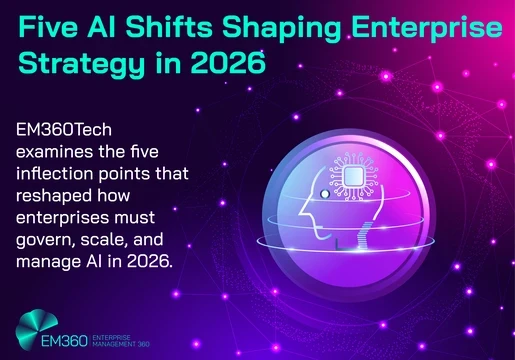

Comments ( 0 )